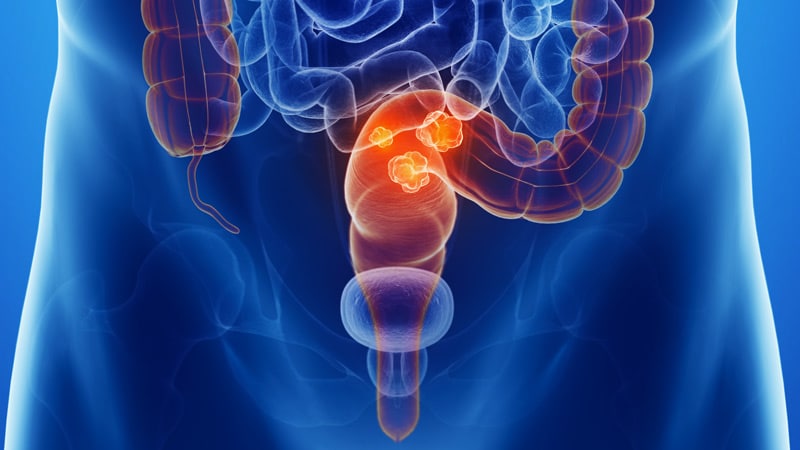Although the number of patients diagnosed with advanced and metastatic rectal cancer has risen, overall survival for patients with this cancer type has improved significantly in recent years, a new analysis concludes.
Five-year overall survival rates rose significantly from 2004 to 2015, from 83.1 months to 92.1 months (P < .001).
The investigators who reported the finding suggest that the improvement is due to treatment trends during the study period (which stretched to 2019). These included a significant increase in the use of chemotherapy, immunotherapy, sphincter-saving surgery, and minimally invasive surgery.
These trends were accompanied by an increase in the time between diagnosis and surgery and were associated with significant improvements in overall survival, reduced conversion rates, and shorter hospital stays.
“The findings of the study are of major clinical relevance to the management of rectal cancer,” the authors write. “The improvements seen in short-term outcomes and survival of patients diagnosed with rectal cancer are probably attributable to the treatment trends observed.”
The article was published online on December 29 in JAMA Oncology.
The study was led by Steven D. Wexner, MD, of the Ellen Leifer Shulman and Steven Shulman Digestive Disease Center, Cleveland Clinic, Ohio.
Using data from the National Cancer Database, the team identified 318,548 patients who were diagnosed with rectal adenocarcinoma from 2004 through 2019. This period was subdivided into four equal periods: 2004–2007, 2008–2011, 2012–2015, and 2016–2019.
The mean age of the patients was 63.5 years; 14.8% of patients were younger than 50 years. The majority of patients (85.1%) were White, 8.9% were Black, 3.4% were Asian, 0.4% were American Indian, and 1.1% belonged to other races and ethnicities.
The majority (95.1%) of tumors were adenocarcinomas; 4.9% were mucinous or signet ring cell carcinomas.
Among the patients, 6.2% had disease of clinical TNM stage 0, 21.7% had stage I disease, 24.8% had stage II disease, 28.0% had stage III disease, and 19.2% had stage IV disease.
The percentage of patients younger than 50 years who were diagnosed with rectal cancer increased by 1.5%, from 13.9% in the first period studied (from 2004–2007) to 15.4% in the last period studied (2016–2019).
Patients in this last period (2016–2019) more frequently presented with stage III disease (36.2% vs 30.2% vs 25.0% vs 23.4%; P < .001) and stage IV disease (21.5% vs 19.3% vs 18.1% vs 18.6%; P < .001) as compared with those in the other three periods.
Treatment Trends and Outcomes
Significant changes in the treatment paradigms of rectal cancer occurred between 2004 and 2019, the authors report.
The use of chemotherapy increased 1.5-fold during these years.
The cutoff year for a remarkable increase in the use of chemotherapy was 2009, which is when a clinical trial found that the addition of chemotherapy after initial neoadjuvant chemoradiotherapy was associated with considerably higher rates of complete response with acceptable toxicity rates, the team noted. Also that year, a Cochrane review concluded that combined preoperative chemotherapy and radiotherapy enhanced the pathologic response and improved local control for stage II and stage III rectal cancer compared with preoperative radiotherapy alone.
There was also an almost 20-fold increase in the use of immunotherapy during the study period. The authors note that in 2015, a phase 2 trial concluded that pembrolizumab yielded an objective response rate of 40% and a progression-free survival rate of 78% for colorectal cancer patients with mismatch repair-deficient disease.
The surgical treatment of rectal cancer has also undergone remarkable change, the team notes. The use of abdominoperineal resection decreased in favor of sphincter-saving surgery. This trend might be related to the increased performance of rectal cancer surgery in specialized, high-volume centers with sufficient resources and adequate surgeon expertise to allow more sphincter-saving procedures to be performed, they suggest.
Another important observation was the reduction in the use of open surgery by 50% (from 60.1% in period 2 to 30.1% in period 4) and the increased adoption of minimally invasive surgery, particularly robotic surgery, which increased by more than fivefold. The authors note that 2015 marked the cutoff for the increased uptake of robotic surgery use. The ALaCaRT trial, which was published that year, did not establish the noninferiority of laparoscopic compared with open surgery for patients with T1 to T3 rectal cancers.
No outside funding for the study was reported. Several of the co-authors report relationships with industry, as noted in the original article.
JAMA Oncol. Published online December 29, 2022. Abstract
Roxanne Nelson is a registered nurse and an award-winning medical writer who has written for many major news outlets and is a regular contributor to Medscape.
For more news, follow Medscape on Facebook, Twitter, Instagram, and YouTube.
Source: Read Full Article
